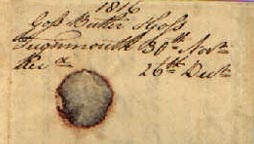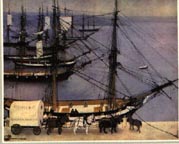Eunice and Ron Shanahan have shared with readers of the Victorian Web this material from their website, Letters from the Past. Click on thumbnails for larger images.
 This letter sent me
fossicking through the reference books. The letter dated 30th November, 1816
is an interesting business letter from Goss, Butler and Goss of Teignmouth -
a port in South Devon, England - to their agents, Messrs Hunt, Newman and Roope
in Oporto, Portugal, where it was received on December 26th.
This letter sent me
fossicking through the reference books. The letter dated 30th November, 1816
is an interesting business letter from Goss, Butler and Goss of Teignmouth -
a port in South Devon, England - to their agents, Messrs Hunt, Newman and Roope
in Oporto, Portugal, where it was received on December 26th.
Oporto (called Porto by the Portuguese) is a port and the second largest city of Portugal. My modern reference suggests the distance between the two is about 730 miles, but it does not explain whether that is ‘as the crow flies’ or that is the shortest distance by sea, using favourable currents. However, in the European winter weather conditions of fog and gales and general discomfort this letter took 26 days to cover the distance. At this time Portugal and England were allies, and there was a fair amount of correspondence and trade between the two countries. There was a weekly Packet service to Lisbon. The mails were made up in London on Tuesdays, and left early Wednesday on the mailcoach to Exeter, which took about 30 hours. From there the bags were taken to Falmouth, and despatched generally on the Saturday morning, if the Packet was in the Falmouth Harbour, and weather permitting.
 The postal markings are
Teignmouth mileage mark, in black ink. This is the standard boxed mileage mark
in use from 1801-1830, and a manuscript charge mark in red ink of P 2/3.
The postal markings are
Teignmouth mileage mark, in black ink. This is the standard boxed mileage mark
in use from 1801-1830, and a manuscript charge mark in red ink of P 2/3.
The postage rates were very complex and instructions were posted continuously to the postmasters advising them to get it right. This 2/3 represents the Falmouth to Oporto, postage of 1/7d plus the inland cost from Teignmouth to Falmouth, which was 8d - for a distance of between 80 and 120 miles. The mileage mark is clearly 192. The entry in Alan Robertson’s book of the official distances, based on the survey by John Cary, published in 1802 - it is given as 187. This is also the distance shown in the Thom and Johnston published list of 1828.
Mileage marks are a very interesting study. For many years the cost of posting a letter was based on the number of sheets, the weight, and the distance carried. The distances varied as new roads were built, or new surveys carried out. In 1784 new office name stamps were issued which included the mileage from London, so the receiving clerk (knowing how far he was from London) added this to the mileage in the stamp of the sending town and was able to check the charge.
During the period of their use these mileage stamps were issued in various forms - straight line, circular, dated, undated, boxed or framed, and with the mileage figure after, above, or below the office name. Some towns used more than one type. However, the mileages were often inaccurate, so in 1797 it was ordered that mileage marks should be removed from the office namestamps, but not all were removed. Postal rates were altered again in 1801 and mileage marks came back into general use. Some early marks had just a mileage number under the office name but the two varieties more frequently adopted as in this example of Teignmouth, showed the mileage under the name either boxed or with with top and bottom lines, but some large offices introduced a mileage number into their straight-line dated marks.
The letter begins:
Gentlemen,
Your esteemed favour of the 19th ult and second November are duly recd. The former covering a draft for £207.4.10 for which together with the transactions be pleased to accept our very sincere thanks.
We have a letter this morning from Mr. G. of the 19th instant informing that a sample vessel of ours - the Mary - William Acland, Master - with about fifteen hundred quintals of fish on our acct would sail from St. Johns about the 20th instant, and there was a probability of our I.G Jnr sending her to Vigo for orders - and if he did this he intended forwarding letter to you, requesting you would inform the Master where he had best proceed to discharge this cargo.
Note: fifteen hundred quintals - this is an old measurement - a quintal is 100 lbs. St Johns is the capital of Newfoundland, the first English Colony, noted for the quantity and quality of codfish in the waters around the island. Vigo is a Spanish port about 150km north of Oporto.
As we have no correspondent at Vigo and not knowing who Mr Goss has written to there, and as the Master is a young man and unacquainted with the nature of the business we shall be particularly obliged by your writing your correspondents at Vigo - desiring he will give the Master such information as the case may require at the same time to write the Master yourselves giving him such direction as you may consider necessary - taking care that it does not interfere with this directions recd at Nfld., to which we are strangers.
Should this vessel discharge where sale is to be obtained reasonable - we should wish about half a cargo to be sent by her to Teignmouth - unless the vessel could obtain a freight to this neighbourhood.
We shall also be obliged by your requesting the sales may be made as expediciously as possible and the proceeds forwarded immediately.
We are sorry to be so very troublesome but trust you will excuse the liberty we have taken and immediately comply with our request.
We are very respectfully Gentlemen Yr Most Obedt. Goss, Butler and Goss.
From the letter, it can be seen that communication was a great problem. How different from nowadays with Global positioning Satellites to pinpoint position, and communication satellites to enable direct ship-to-shore phone and facsimile links.
 "Mails
for the Packets arriving at Falmouth, 1833" by H.S. Williamson, Principal
of the Chelsea School of Art. National Postal Museum postcard number 88/4. From
the Post Office Archives' Poster Artwork Collection.
"Mails
for the Packets arriving at Falmouth, 1833" by H.S. Williamson, Principal
of the Chelsea School of Art. National Postal Museum postcard number 88/4. From
the Post Office Archives' Poster Artwork Collection.
Imagine this young Wm Acland, Master of the Mary guiding his ship in the freezing fog across the North Atlantic with a cargo of 150,000 lbs of fish, aiming for Vigo in Spain, not knowing if there will be a message for him, or if he is to discharge half or all of his cargo in order to take on another for England. Life must have been very adventurous.
Sources
Philips' Illustrated Atlas.
Hutchinson’s Encyclopaedia.
Alcock & Holland, British Postmarks.
Alan Robertson, Post Roads, Post Towns and Postal Rates 1635-1839.
Edmund Vale, Mail-Coach Men of the Eighteenth Century.
David Robinson, For the Port and Carriage of Letters,
C. Tabaert, United Kingdom Letter Rates 1657-1900 Inland and Overseas.
Last modified 18 December 2002